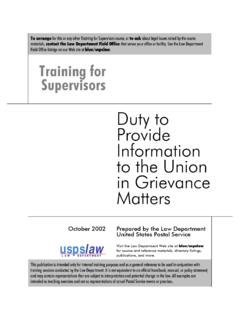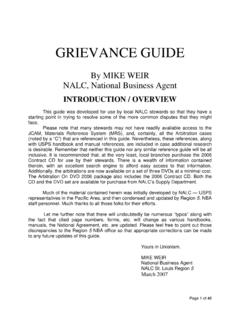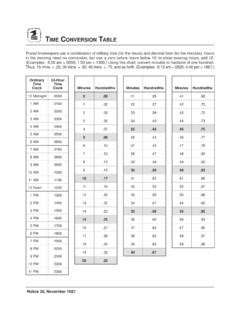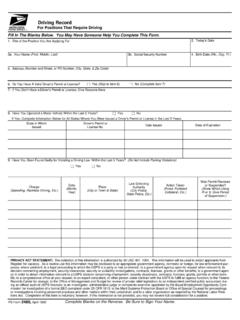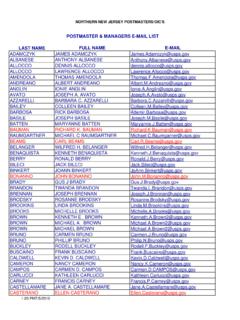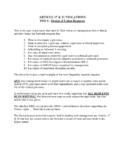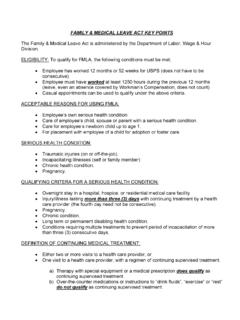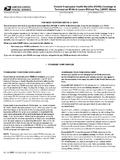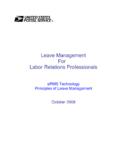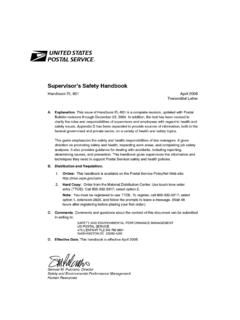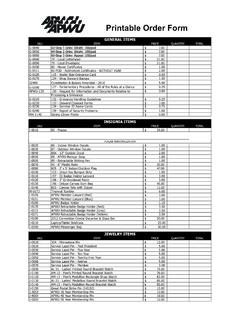Transcription of Supervisor’s Safety Handbook - NEW JERSEY …
1 RSupervisor s Safety HandbookHandbook EL-801 May 2001 Transmittal LetterA. Explanation. This issue of Handbook EL-801 is a complete revision. With the passageof the Postal Employees Safety Enhancement (PESEA), effective September 1998, thePostal Service is now treated as a private sector employer and, as such, it is required toprovide guidance to management personnel. This Handbook incorporates therequirements of that guide emphasizes the day-to-day Safety and health responsibilities of linemanagement. It gives direction on determining accident causes, reporting accidents,inspecting work areas, promoting Safety and health, and completing job Safety provides supervisors with the information and techniques needed to support currentsafety and health Distribution and Copy. Order copies of Handbook EL-801 from the Material Distribution Cen-ter using Form 7380, Material Distribution Center Supply Touch Tone Order Entry by calling 1-800-332-0317, option 1, then a F3 Fill-completed PS Form 7380 by cc:Mail to MDC Customer Serviceat a completed PS Form 7380 to the following Copy: Handbook EL-801 appears on the Postal Service intranet and questions about the content of this document can be submitted in writingto: Safety PERFORMANCE MANAGEMENTUS POSTAL SERVICE475 L ENFANT PLAZA SW RM 9801 WASHINGTON DC 20260-4261D.
2 Effective Date. This Handbook is effective upon F. MedvidovichSenior Vice PresidentHuman ResourcesContents3 May 2001 Contents1 Accident Prevention11.. 1-1 supervisor s Responsibilities11.. 1-2 Postal Service Safety Philosophy11.. 1-3 Good Safety Supervision12.. 1-4 Employee Rights and Responsibilities14.. 1-5 Your Responsibility When Employees Report Hazards14.. 1-6 The Role of the Safety Professional16.. 1-7 Safety Talk Requirements17.. 2 Accident Investigation19.. 2-1 Purpose of an Accident Investigation19.. 2-2 Investigating an Accident19.. 2-3 Preparing the Accident Report21.. Form 1769, Accident Report21.. the Accident Report21.. of Corrective Measures21.. Causative Factors22.. Investigation Follow-Up23.. 2-4 Requirements for Reporting Fatalities and Serious Accidents23.. Serious Accidents23.. to the Occupational Safety and Health Administration SpecialCircumstances24.
3 3 Delivery Operations25.. 3-1 Animal Interference25.. Action for Animal Bites26.. 3-2 Defective Equipment and Machinery26.. 3-3 General Office and Delivery Safety Rules26.. Mail26.. Conditions27.. and Flat Cases27.. of Letter and Flat Cases28.. Delivery and Collection Boxes28.. , Trips, and Falls28.. Delivery Points28.. supervisor s Safety Handbook4 Handbook EL 8013-4 Rural Delivery Operations29.. Approaches to Boxes and Passable Roads29.. Driving Practices29.. 3-5 Motor Vehicle Safety30.. Responsibilities30.. Requirements30.. to Operate Motor Vehicles30.. Vehicle Safety Rules30.. Vehicles31.. Vehicles32.. Vehicles32.. Belts and Vehicle Doors32.. Driver Award Program33.. 4584, Observation of Driving Practices33.. 4 Processing and Distribution Operations35.. 4-1 Automated Equipment35.
4 4-2 Mechanized Hamper Dumpers and Lifts36.. 4-3 Dock Plates36.. 4-4 Dock or Scissors Lifts36.. 4-5 Glove Safety36.. 4-6 Yard and Dock Operations37.. 4-7 Powered Industrial Trucks37.. Rules for Operating PIT38.. Trucks38.. Warning Devices and Protective Equipment39.. Wheeled Equipment39.. 5 Facility Maintenance Operations41.. 5-1 Compressed Air41.. 5-2 Electrical Equipment41.. Breakers and Fuse Boxes41.. and Extension Cords42.. Contents5 May 20015-3 Machine Guards43.. Wheel Machinery43.. 5-4 Welding Operations44.. and Marking of Cylinders44.. Pressure of Cylinders44.. Procedures44.. Protective Equipment for Welding Operations44.. Screens45.. Requirements45.. Cylinders45.. 5-5 Personal Protective Equipment46.. and Selection46.. Guidelines46.. and Face Protection47.. 6 Vehicle Maintenance Facility Operations49.
5 6-1 Vehicle Repairs49.. Repairs49.. Exhaust Vapors49.. Under Vehicles49.. Glass Windshields and Doors49.. 6-2 Flammable Materials50.. Parts50.. Pumps50.. of Flammable Liquids50.. of Oily Rags and Flammable Waste50.. Containers50.. 6-3 Handling Batteries50.. 6-4 Portable Electric Hand Tools and Equipment51.. 6-5 Slippery Floors51.. 6-6 Stationary Grinders51.. 6-7 Tire Safety Cage51.. 6-8 Personal Protective Equipment for VMF Employees51.. 7 Air Mail Facility Operations53.. 7-1 Operation of Motor Vehicles on the Airfield53.. 7-2 General Rules and Regulations53.. 7-3 Use of Motorized Transport Equipment on Aircraft Operation Areas at Airports54.. supervisor s Safety Handbook6 Handbook EL 8018 General Safety Rules and Regulations55.. 8-1 Leaking Packages55.. 8-2 Caution and Warning Signs55.. 8-3 Defective Equipment56.
6 8-4 Electrical Cords and Receptacles56.. 8-5 Fire Prevention56.. Action Plan57.. Prevention Plan57.. Equipment Color Coding57.. Drills58.. Appliances58.. Lighting58.. Telephone Numbers59.. and Signs59.. Evacuation Teams60.. Extinguishers60.. Inspections61.. 8-6 First Aid61.. Aid Kits61.. 8-7 Floors62.. Cleaning62.. Floors63.. 8-8 Footwear63.. of the Shoe63.. and Soles63.. Shoes64.. 8-9 Furniture and Equipment Anchoring64.. Cabinets and Distribution Cases64.. Wall Lockers, Storage Shelves, and Storage Cabinets64.. Furniture64.. Racks, Recruitment Posters, and Bicycle Racks65.. 8-10 Housekeeping65.. Objects65.. Locker Inspections66.. Contents7 May on Top of Lockers66.. 8-11 Knives and Cutting Devices66.. 8-12 Lifting66.. for Lifting67.. Lifting and Carrying Procedures67.. for Lifting Parcels67.
7 For Lifting Sacks70.. 8-13 Observation of Work Practices71.. 8-14On-the-Job Safety Review Analysis Form 178371.. Suitable Jobs72.. Your JSA72.. Your JSA76.. Your JSA76.. 8-15 Parking Lot, Platform, Driveway, and Sidewalk Maintenance76.. and Ice Removal76.. 8-16 Personal Safety and Crime Prevention77.. 8-17 Radio Headsets77.. 8-18 Required Postings77.. 8-19 Rest Bars78.. Body Positions78.. of Rest Bars78.. 8-20 Slip, Trips, and Falls79.. 8-21 Smoking79.. 8-22 Solvents and Other Chemicals79.. of Cleaning Solvents79.. of Solvents80.. Safety Data Sheets80.. 8-23 Workstation Position Adjustments80.. Chair80.. Practices82.. supervisor s Safety Handbook8 Handbook EL 801 Appendix A Frequently Used Acronyms83.. Appendix B Local Safety Policies and Procedures85.. Appendix C Emergency Telephone Numbers87.
8 Appendix D Safety Reference Material89.. Exhibits9 May 2001 ExhibitsExhibit 1-313.. Seven Keys to Good Safety Supervision13.. Exhibit 1-5a15.. Excerpt From Title 29, Code of Federal Regulations15.. Exhibit 1-5b16.. Form 176716.. Exhibit .. Fingering Mail27.. Exhibit .. Seat Belts and Vehicle Doors33.. Exhibit .. Pinched Spine Drawing67.. Exhibit .. Proper Lifting Technique69.. Exhibit .. Proper Technique for Lifting Sacks70.. Exhibit .. Form 1783, On-the-Job Safety Review/Analysis73.. Exhibit .. Guide to Preparing a JSA75.. Exhibit .. Workstation Chair Adjustments81.. 1-2 Accident Prevention11 May 20011 Accident Prevention1-1 supervisor s ResponsibilitiesThe Occupational Safety and Health Act requires employers to provide a safeand healthful workplace free of recognized hazards and to followOccupational Safety and Health Administration (OSHA) responsibilities also include providing training, medicalexaminations, and record a Postal Service supervisor , you are the backbone of our Safety andHealth Program.
9 You are in a highly visible leadership position that requiressetting the standard for accident prevention. You are responsible forimplementing written programs and action plans, monitoring employees Safety performance, and preventing operational Safety errors. To properlyexercise your responsibility, you must know the Postal Service Safety rulesand regulations and the rights and responsibilities of the employees yousupervise. (Employees rights and responsibilities are explained in 1-4.) Safety rules and regulations are found in (a) this Handbook , (b) HandbookEL-814, Postal Employee s Guide To Safety , (c) Chapter 8 of the Employeeand Labor Relations Manual (ELM), (d) Handbook EL-803, MaintenanceEmployee s Guide To Safety , and (e) other Postal Service publications Postal Service Safety PhilosophyIt is the position of the Postal Service injury can be prevented.
10 This goal is realistic, not just or managers having primary responsibility for thewell-being of employees must fully accept this , including all levels through the initial-level supervisor , isresponsible and accountable for the prevention of accidents and controlof resultant losses. Just as the line organization is responsible forattaining production levels, ensuring quality of performance,maintaining good employee relations, and operating within cost and1-3 supervisor s Safety Handbook12 Handbook EL 801budget guidelines, supervisors and managers must likewise accepttheir share of responsibility for the Safety and health of is possible to safeguard all operating exposures that can result inaccidents and injuries. It is preferable to eliminate the sources ofdanger. However, where this is not practical, management must useprotective measures, such as machine guards, Safety devices, andpersonal protective equipment, and take administrative employees must be trained in proper work procedures and must beeducated to work safely and to understand that they are responsible fordoing so.
